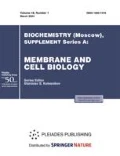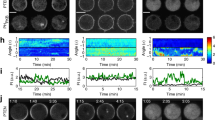Abstract
The possibility of tight coupling of phospholipase C with the signal pathway PI3K/ PTEN, a ubiquitous mechanism for the control of chemotaxis and cell shape in free-living amoebae and mammalian tissue cells, has been investigated in Physarum polycephalum plasmodium, a multinuclear amoeboid cell with the autooscillatory mode of motility. It was found that on the maintenance of contractile autooscillations and protoplasmic shuttle streaming, U73122, an inhibitor of the signal transduction to phospholipase C, induces degradation of the plasmodium frontal zone, decreases efficiency of locomotion and suppresses the chemotaxis toward glucose as well as the response of oscillator to this attractant. The identity of the effects of U73122 with those shown for wortmannin and LY294002, widely used PI3K inhibitors (Matveeva et al. 2008. Biophysics. 53, 533–538), suggests a tight coupling of the signal pathways of phospholipase C and PI3K/PTEN. U73122 increases the period of contractile oscillations and abolishes its cyclic changes attributed for the plasmodium migration. The results indicate that motile behavior of the plasmodium is under the receptor-mediated control.
Similar content being viewed by others
Abbreviations
- PIP2 :
-
phosphatidylinositol-4,5-bisphosphate
- PIP3 :
-
phosphatidylinositol-3,4,5-trisphosphate
- IP3 :
-
inositol-1,4,5-trisphosphate
- IP3R:
-
inositol-1,4,5-trisphosphate receptor
- PI3K:
-
phosphoinositide-3-kinase
- PTEN:
-
phosphatidylinositol-3-phosphatase, tensin homolog
- PLC:
-
phospholipase C
- PH-domain:
-
plekstrin homology domain, a protein module first found in plekstrin
- C2 domain:
-
a protein module in PLC molecule
- Gα, Gβγ:
-
subunits of trimeric G-protein complex
- U73122-1-[6-[[(17β)-3-Methoxyestra-1,3,5(10)-trien-17-yl]amino]hexyl]-1H-pyrrole-2,5-dione:
-
an aminosteroid and the inhibitor of receptor activation of PLC
- LY294002:
-
PI3K inhibitor
References
Fleischer M., Wohlfarth-Bottermann K.E. 1975. Correlation between tension force generation, fibrillogenesis and ultrastructure of cytoplasmic actomyosin during isometric and isotonic contraction of protoplasmic strands. Cytobiologie. 10, 339–365.
Teplov V.A. 2010. Cytomechanics of oscillatory contractions. Modeling the longitudinal dynamics of Physarum polycephalum protoplasmic strands. Biofizika (Rus.). 55(6), 987–995.
Kuroda R., Hatano S., Hiramoto Y., Kuroda H. 1988. Change of cytosolic Ca-ion concentration in the contraction and relaxation cycle of Physarum microplasmodia. Protoplasma. Suppl. 1, 72–80.
Beylina S.I., Matveeva N.B., Teplov V.A. 1996. Autonomous motile activity of Physarum polycephalum plasmodium. Biofizika (Rus.). 41(1), 133–138.
Bliokh Zh.L., Smolyaninov V.V. 1977. Kinematics of protoplast spreading. II. Individual locomotive activity. Biofizika (Rus.). 22(4), 631–639.
Satoh H., Ueda T., Kobatake Y. 1985. Oscillations in cell shape and size during locomotion and in contractile activities of Physarum polycephalum, Dictyostelium discoideum, Amoeba proteus and macrophages. Exp. Cell Res. 156, 79–90.
Giannone G., Dubin-Thaler B.J., Dobereiner H-G., Kieffer N., Bresnick A.R., Sheetz M.P. 2004. Periodic lamellipodial contractions correlate with rearward actin waves. Cell. 116, 431–443.
Devreotes P., Janetopoulos C. 2003. Eukaryotic chemotaxis: Distinctions between directional sensing and polarization. J. Biol. Chem. 278, 20445–20448.
Kolsch V., Charest P.G., Firtel R.A. 2008. The regulation of cell motility and chemotaxis by phospholipid signaling. J. Cell Sci. 121, 551–559.
Iijima M., Devreotes P. 2002. Tumor suppressor PTEN mediates sensing of chemoattractant gradients. Cell. 109, 599–610.
Matveeva N.B., Beylina S.I., Teplov V.A. 2008. Role of phosphoinositol-3-kinase in regulation of shape and directed motion of Physarum polycephalum plasmodium. Biofizika (Rus.). 53(6), 986–992.
Matveeva N.B., Teplov V.A., Beylina S.I. 2010. Suppression of the autooscillatory contractile activity of Physarum polycephalum plasmodium by the inhibitor of the IP3-induced Ca2+ release 2-aminoethoxydiphenyl borate. Biochemistry (Moscow). Suppl. Ser. A: Membrane and Cell Biology. 4(1), 70–76
Liao H.-J., Carpenter G. 2004. Phospholipase C. In: Handbook of Cell Signaling. Eds Bradshaw R.A., Dennis E.A. London, Oxford, New York, San Diego: Acad. Press. V. 2, p. 5–9.
Camp W.G. 1936. A method of cultivating myxomycete plasmodia. Bull. Torrey Bot. Club. 63, 205–210.
Wohlfarth-Botterman K.E., Stockem W. 1970. Die Regeneration des plasmalemmas von Physarum polycephalum. Wilhelm Roux’s Arch. Entwicklungsmech. Org. 164, 321–340.
Ilyasov F.E., Morozov M.A., Teplov V.A. 2008. Cytomechanics of Oscillatory contractions. 1. Measurement of active mechanical properties of Physarum polycephalum plasmodium strands. 1. Biofizika (Rus.). 53(6), 1044–1050.
Matveeva N.B., Klyueva A.A., Teplov V.A., Beylina S.I. Effect of pharmacological activators and inhibitors of ryanodine receptor on autooscillatory contractile activity of Physarum polycephalum plasmodium. Biochemistry (Moscow). Suppl. Ser. A: Membrane and Cell Biology. 20(1), 66–71.
Rakoczy L. 1973. The myxomycete Physarum nudum as a model organism for photobiological studies. Ber. Deutsch. Bot. Ges. 86, 141–164.
Horowitz L.F., Hirdes W., Suh B.-Ch., Hildemann D.W., Mackie K., Hille B. 2005. Phospholipase C in living cells: Activation, inhibition, Ca2+ requirement, and regulation of M current. J. Gen. Physiol. 126, 243–262.
Klein R.R., Bourdon D.M., Costales C.L., Wagner C.D., White W.L., Williams J.D., Hicks S.N., Sondek J., Thakker D.R. 2011. Direct activation of human phospholipase C by its well known inhibitor U73122. J. Biol. Chem. 286, 12407–12416.
Beilina S.I., Matveeva N.B., Priezzhev A.V., Romanovskiy Yu.M., Sukhorukov A.P., Teplov V.A. 1984. Plasmodium of the myxomycete Physarum polycephalum as an autowave self-organizing system. In: Self-organization Autowaves and Structures Far from Equilibrium. Ed. Krinsky V.I. Berlin Heidelberg NY Tokyo: Springer-Verlag, p. 218–221.
Welton R.M., Hoffman C.S. 2000. Glucose monitoring in fission yeast via the gpa2 G, the git5 Gα and the git3 putative glucose receptor. Genetics. 156, 513–521.
Nezvetskiy A.R., Orlova T.G., Beylina S.I., Orlov N.Ya. 2006. Thermostable extracellular cyclic nucleotide phosphodiesterase from Physarum polycephalum plasmodium. Biofizika (Rus.). 51(5), 810–816.
Matveeva N.B., Morozov M.A., Nezvetskiy A.R., Orlova T.G., Teplov V.A., Beylina S.I., 2010. Involvement of extracellular cAMP-specific phosphodiesterase in control of motile activity of Physarum polycephalum plasmodium. Biofizika (Rus.). 55.(6), 1076–1082.
Drayer A.L., Van der Kaay J., Mayr G.W., Van Haastert P.J. 1994. Role of phospholipase C in Dictyostelium: Formation of inositol 1,4,5-trisphosphate and normal development in cells lacking phospholipase C activity. EMBO J. 13(7), 1601–1609.
Kortholt A., King J.S., Keizer-Gunnink I., Harwood A.J., Van Haastert P.J.M. 2007. Phospholipase C regulation of phosphatidylinositol 3,4,5-trisphosphate-mediated chemotaxis. Mol. Biol. Cell. 18, 4772–4779.
Van Haastert P.J.M., Keizer-Gunnink I., Kortholt A. 2007. Essential role of PI3-kinase and phospholipase A2 in Dictyostelium discoideum chemotaxis. J. Cell Biol. 177(5), 809–816.
Chen L., Iijima M., Tang M., Landree M.A., Huang Y.E., Xiong Y., Iglesias P.A., Devreotes P.N. 2007. PLA2 and PI3K/PTEN pathways act in parallel to mediate chemotaxis. Dev. Cell. 12, 603–614.
Van Dijken P., Bergsma J.C., Van Haastert P.J.M. 1997. Phospholipase-C-independent inositol 1,4,5-trisphosphate formation in Dictyostelium cells. Activation of a plasma-membrane-bound phosphatase by receptorstimulated Ca2+ influx. Eur. J Biochem. 244(1), 113–119.
Rebecchi M.J., Pentyala S.N. 2000. Structure, function, and control of phosphoinositide-specific phospholipase C. Physiol. Rev. 80, 1291–1335.
Author information
Authors and Affiliations
Corresponding author
Additional information
Original Russian Text © N.B. Matveeva, V.A. Teplov, S.I. Beylina, 2012, published in Biologicheskie Membrany, 2012, Vol. 29, No. 3, pp. 183–194.
The article was translated by the authors.
Rights and permissions
About this article
Cite this article
Matveeva, N.B., Teplov, V.A. & Beylina, S.I. Coupling of phospholipase C and PI3K/PTEN signaling pathways in Physarum polycephalum: The action of U73122 on motile and autooscillatory activity of plasmodium. Biochem. Moscow Suppl. Ser. A 6, 255–264 (2012). https://doi.org/10.1134/S1990747812030142
Received:
Published:
Issue Date:
DOI: https://doi.org/10.1134/S1990747812030142



